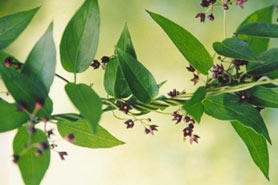Black swallow-wort
(Vincetoxicum nigrum)
Herbaceous, perennial vine that twines 3-6’ tall with small hairs on the stems and seed pods similar to milkweed. Plants spread vegetatively and reproductively.
Other names for this plant include:
- Common names: dog-strangling vine, climbing milkweed, Louis' swallow-wort
- Scientific names: Cynanchum louiseae; C. nigrum
Classification in Wisconsin: Prohibited/Restricted
- Ecological Threat
-
- It invades the understory of forests, woodland edges, grasslands and old fields covering native vegetation and forming dense thickets. Tolerant of sun and shade.
- Black swallow-wort is shown to reduce monarch butterfly populations.
- Grassland bird presence greatly decreases as infestations expand.
- Identification
-
Leaves: Opposite, oval and smooth. Leaves are dark green and shiny with pointed tips and short petioles; 2-5” long.
Flowers: Black swallow-wort has dark purple flowers with 5 triangular petals in a star shape covered with fine, white hairs. Umbel-like, branched clusters have 6-10 flowers that bloom June-July.
Fruits & seeds: Slender pods, similar to milkweed, are 2-3” long, form in late July-August and turn from green to light brown or golden as they mature. Seeds are flat and attached to thin filaments that aid in wind dispersal, similar to milkweed.
Roots: Black swallow-wort forms dense, knobby masses of rhizomes that sprout new plants forming extensive patches.
Similar species: Pale swallow-wort (Vincetoxicum rossicum; syn. Cynanchum rossicum; invasive) is the same as black swallow-wort with the exception of the maroon to pale pink flowers with petals that are longer than wide and hairless.
- Control
- Mechanical: Remove all seed pods before they open and either burn or dispose of in a landfill; most effective if done in mid-July. If plants are dug up, all root fragments and root crown must be removed before seeds ripen.
Chemical: Cut-stem treatment with glyphosate. Foliar spray or wicking in August-September with either triclopyr ester or glyphosate and a surfactant after the infestation is mowed and new growth has formed. Foliar treatment should begin after flowering but before seed production.
For more information on control techniques, visit the Black swallow-wort factsheet [exit DNR] by the University of Wisconsin-Extension.
- Resources
- Sources for content:
- Czarapata, Elizabeth; Invasive Plants of the Upper Midwest: an illustrated guide to their identification and control. University of Wisconsin Press. 2005. Pg. 132-133
- Plant Conservation Alliance's Alien Plant Working Group. Weeds Gone Wild: Alien Plant Invaders of Natural Areas. Black Swallow-wort [exit DNR]



